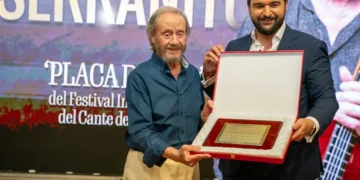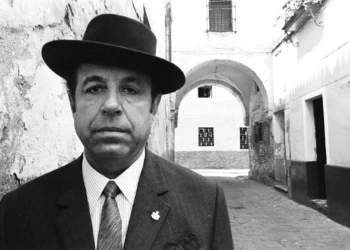|
50th Festival Internacional de
|
|
Special 50 Festival Internacional del Cante de las Minas. Text: Estela Zatania Friday at the Festival de La Unión began with the conference “Las Letras del Flamenco” by poet and writer José Manuel Caballero Bonald, who then received the Extraordinary Prize for Literary Art. The vice-consul of the Culture Department of the Junta de Andalucía presented the campaign “Flamenco Soy” to promote the candidacy of flamenco to receive the UNESCO designation as World Heritage. The main event of the day was the show at the Catedral del cante by Granada singer Enrique Morente, who will also receive the Castillete de Oro. In 2004, Morente received the tribute of the Festival de La Unión. As the emcee said, “Morente is a performer no one is indifferent to”, a thinly-veiled statement that obliquely refers to the division of opinion among flamenco fans: in Madrid and eastern Andalusia the singer is number one, the most, the greatest star of flamenco singing. But in western Andalusia he is not always so well-accepted. It’s important to take note of this, because on Friday night Morente’s show at La Unión managed to partially penetrate that barrier and win the respect of many from the “other side”. If José Menese is the youngest of the old maestros, Morente is the oldest of the avant-garde set. But oddly enough, both maestros were born the same year, 1942, which is eloquent proof of the evolution of flamenco in the last half-century, the same space of time the Festival de La Unión has existed, which in turn is this year being celebrated. The Granada man’s curriculum runs parallel to the evolution of the musical form to which he has dedicated his life. As a young man he made it his business to learn and absorb the knowledge that would in later years allow him to embark on his own path without ever losing sight of the essence. The beginning of the show doesn’t vary: Morente in a circle of men with strong overhead spot, his tonás, his reverb and his regular backup, the solid vocal and percussive accompaniment of Antonio Carbonell, Angel Gabarre and Enrique Morente junior, the compás of Bandolero, the excellent guitar of David Cerreduela and the extraordinary participation of the much-admired Rafael Riqueni. Beautiful arrangements of overlapping vocals make it all seem more like a chant than cante. From standing in a circle, the men move on to sitting at a table where they keep rhythm with palmas and knuckles. The guitars play a classic caña opening to prelude the cante, and the singer responds with his admirable version of this half-forgotten cante which you could hardly do more with than what Morente squeezes out. Alegrías is a meticulously constructed arrangement. It’s become fashionable to sacrifice spontaneity for beauty, a trade-off Morente manages well thanks to the knowledge that allows him to alternate classic styles with original creations so that flamenco fans always have something to latch onto. The same formula of classic cante to adorn personal creations is the motor that moves the compás of tientos. Malagueña de Chacón dissolves into abandolao cante, and a musical modulation makes it possible to sing a fandango of Albayzín to end. Following this, siguiriyas, or at least the compás of siguiriyas, because Morente helps himself to the same freedom of repertoire most singers only claim for bulerías. Once again the circle formation, and the man from Granada makes it tough for those who like to cite his deficiency in bulerías. A capella, with a wide range of styles, both standard and cuplé, he is secure and relaxed, and the galactic dancing of Gabarre junior responds effortlessly to the rhythmic drone. But it’s not the fiesta finale, there’s still cante de Levante, stylized and Morentized, taranto in 4/4 time as if for dance, a little tic-toc from the Pequeño Reloj, tangos as is only fitting for someone from Granada and more cante abandolao to round out nearly two hours of singing without a break.
More information: |


























